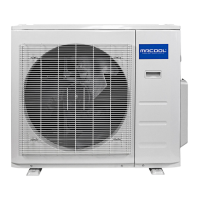Page 46mrcool.com
Refrigerant Piping Connection
AFTER PERFORMING GAS LEAK CHECKS
After confirming that all of the refrigerant
piping connection points DO NOT leak, replace
the valve cover on the outside unit.
8
BEFORE TEST RUN
9
There are two different methods to check for
gaseous leaks. Use Fig. 9.1 below as a guide for the
critical points to check for leaks.
Soap and Water Method
Using a soft brush or spray bottle, apply a soapy
water solution to all of the pipe connection points of
the indoor and outdoor units, watching to see if any
bubbles form. The presence of bubbles indicates
there is a leak.
Leak Detector Method
If using a leak detector, refer to the device’s
operation/instruction manual for proper usage
instructions.
Gas Leak Checks
Electrical and Gas Leak Checks
IF ELECTRICAL LEAKAGE IS DETECTED
If electrical leakage is detected, turn off the
unit immediately and call a licensed
electrician to find and resolve the cause of the
leakage.
After installation is complete, confirm that all
electrical wiring has been installed in accordance
with local and national regulations, and according to
this installation manual.
Check Grounding Work
Measure grounding resistance by visual detection
and with a grounding resistance tester. Grounding
resistance must be less than 0.1Ω.
NOTE: This may not be required for some
locations in North America.
Check for Electrical Leakage
During the Test Run, use an electroprobe and
multimeter to perform a comprehensive electrical
leakage test.
NOTE: This may not be required for some
locations in North America.
Electrical Safety Checks
DURING TEST RUN
NOTE: The illustration shown above in Fig. 9.1
is for demonstration purposes only. The
connection points of a single zone condenser
are pictured. If installing a multi-zone
condenser be sure to check all of the indoor
and outdoor unit connection points and piping
for leaks.
Before Test Run
Only proceed with performing a test run after you
have completed the following steps:
• Electrical Safety Checks - Confirm that all of the
wiring and electrical connections are secure, safe,
and installed in accordance with any and all
electrical codes.
• Gas Leak Checks - Confirm that the gas and liquid
(high & low pressure) valves are fully opened. If
installing a 3, 4, or 5 zone condenser, also
ensure the high & low pressure main valves
are fully opened. Then, check and confirm all
flare nut connections do not have any leaks by
using the leak detection methods described to the
right.
WARNING – ELECTRICAL SHOCK RISK
ALL WIRING MUST BE INSTALLED BY A
LICENSED ELECTRICIAN AND COMPLY WITH
LOCAL, STATE, AND NATIONAL ELECTRICAL
CODES.
A: Low pressure stop valve
B: High pressure stop valve
C & D: Indoor unit flare nuts
Check-point of indoor unit
Check-point of outdoor unit
A
B
C
D
Fig. 9.1

